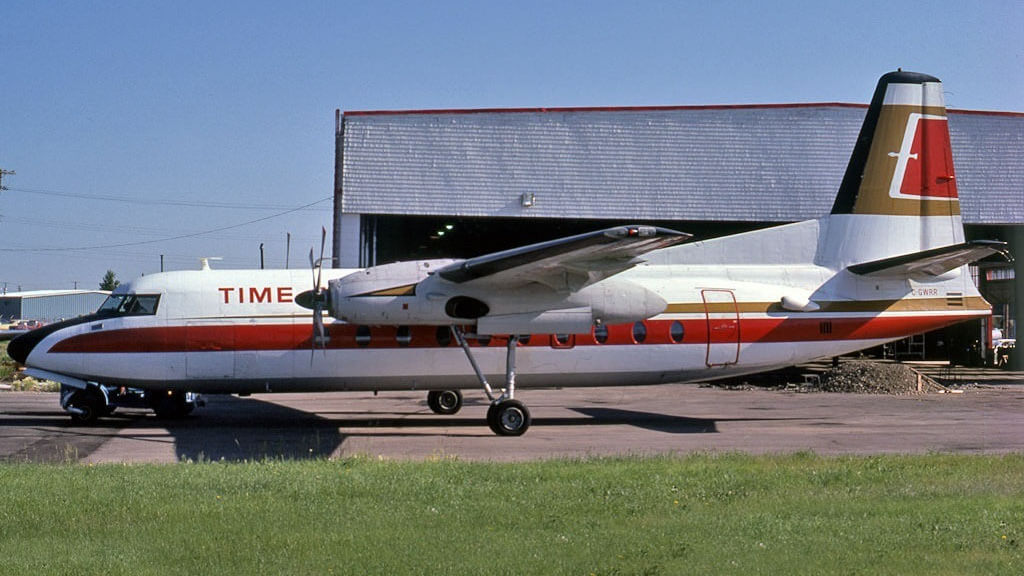Fairchild F27

Photo Credit: Joop de Groot Collection
The Fairchild F27 was a version of the Fokker F27 Friendship, a turboprop airliner developed and manufactured by Dutch aircraft manufacturer Fokker, manufactured under license by Fairchild Hillier in the United States of America.
Developed during the early 1950s, the intent was to produce a capable successor to the earlier piston engine-powered airliners. Piston engine aircraft such as the Douglas DC-3 had become commonplace on the market . A key innovation of the Fokker F27 was the adoption of the Rolls-Royce Dart turboprop engine. Dart engines produced substantially less vibration and noise providing improved conditions for passengers. Another major comfort feature was a pressurized cabin. Innovative manufacturing techniques were also employed in the aircraft’s construction.
Fokker evaluated several potential configurations for the aircraft, including the use of Wright Cyclone radial engines. They finally settled upon a high-wing aircraft, which was furnished with a pair of Rolls-Royce Dart turboprop engines. The Dart engine had already proven successful on the early models of the Vickers Viscount.
The first protype was a pressurized cabin design seating a total of 28 passengers. However – to correct a slight tail-heaviness in the aircraft and to allow for more seats, the second prototype (which first flew in January 1957) had a 3-foot-longer (0.91 m) fuselage, which would allow seating for 32.
A high-mounted wing had been selected as it produced a higher lift coefficient than its lower counterpart. The high wing design also enabled easier ground loading due to a lower floor level and provided unfettered external views to passengers without any weight increase. In the aircraft’s construction, Fokker used an innovative metal-to-metal bonding technique called Redux. This new technique resulted in a longer fatigue life, improved aerodynamics, and a lighter structure. The Fokker Aircraft Company became the first such company after de Havilland to employ such means.
Fairchild F-27s differed from the initial Fokker F27 Friendship Mk 100s in having basic seating for 40, heavier external skinning, a lengthened nose capable of housing a weather radar, and additional fuel capacity. They also incorporated a passenger airstair door in the rear of the aircraft, operated by a flight attendant, which eliminated the need for separate stairs on the ground.
Technical Specifications
| Crew: | 2 Pilots – 1 Flight Attendant |
| Capacity: | 40 Passengers |
| Length: | 82 ft 3 in (25.06 m) |
| Wingspan: | 95 ft 2 in (29.01 m) |
| Height: | 28 ft 7 in (8.71 m) |
| Wing Area: | 720 sq ft (70 m2) |
| Empty Weight: | 22923 lb (10398 kg) |
| Max Takeoff Weight: | 43500 lb (19731 kg) |
| Fuel Capacity: | 1364 US Gal |
| Max Payload: | 8250 lbs |
| Powerplant: | 2 × Rolls Royce Dart RDa.7/2 Mk.529 turboprop engines, 2100 shp (1565.97 kW) each |
| Propellers: | 4-bladed Rotol constant speed propellers |
| Cruise speed: | 260 kts (270 mph, 430 km/h) at 25,000 ft (7600 m) |
| Range: | 1300 nmi (1450.902 mi, 2335 km) |
| Service Ceiling: | 29495 ft (8900 m) |
Aircraft Registration
| Registration | MSN |
| C-GWRR | 13 |
| C-GCRA | 52 |
| C-FGZJ | 53 |
